The role of the Spectroscopy and Biophysics Core is to provide instrumentation, training and support for any type of experimental work involving biophysical and spectroscopic measurements. Although most of the instruments listed below are configured for use on small molecule and protein characterization, the services that our core provides can be extended to partially purified proteins, whole cell assays and analysis of tissues. The instrumentation is located in rooms E155 and N113B of the Beadle Center and includes an Inductively Coupled Plasma Mass Spectrometer (Agilent 7500 cx), an HPLC with diode array detector (Agilent LC1200), a 96-well plate autosampler (Elemental Scientific Inc), a Stopped Flow rapid kinetics instrument (Hi Tech) with fluorescence and Diode Array Detection, a differential scanning calorimeter (Microcal), an isothermal calorimeter (Microcal) and a Spectrofluorimeter (Varian, Cary Eclipse) plus a mini SPR from Forte Bio (Blitz).
Sample Request Form - Spectroscopy Sample Request Form - ICP-MS Service Center Rates Payment Page
Director
Javier Seravalli, PhD
E157 Beadle Center
jseravalli1@unl.edu
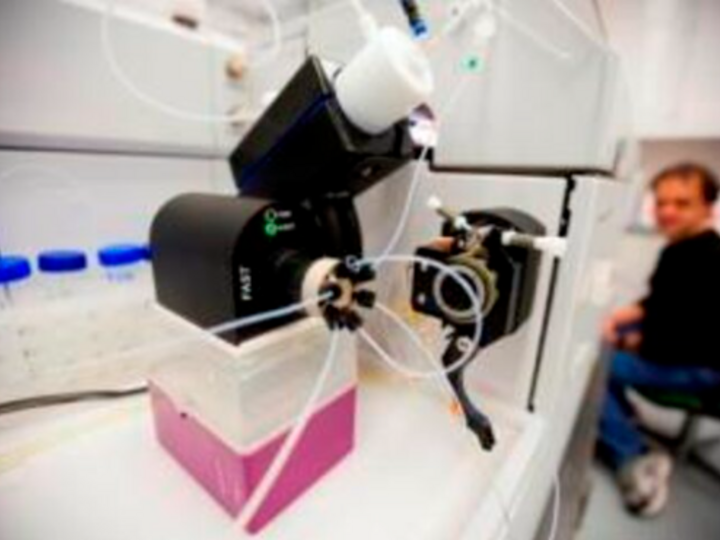
Services Offered by the RBC Spectroscopy Facility
Inductively Coupled Plasma Mass Spectrometer (ICP-MS)
The Agilent 7500cx inductively coupled plasma mass spectrometer (ICP-MS) has a 96-well autosampler which can handle as little as 100 uL per sample injection. Typically a total of 20 elements (not including C, H, N, O, F, and Si) can be quantitated in a single injection. The instrument is equipped with both He (collision) and H2 (reaction) modes of detection through the octopole reaction cell (ORS), for the detection of challenging isotopes such as 40Ca, 56Fe and 78Se. The facility has worked with all types of biological, organic and inorganic samples over the last 16 years.
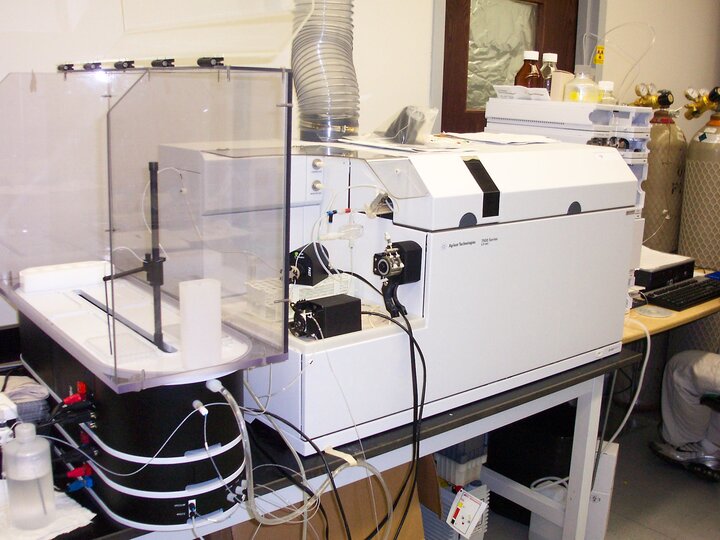
Stopped flow (SF)
The Tgk-Scientific stopped-flow for the study of rapid kinetics equipped with absorbance, fluorescence, and chemical quench detection methods. The instrument also has a 330-700 nm diode-array detection for absorbance with an integration time down to ~1 ms and a double-mixing accessory for the generation of unstable reaction intermediates. The instrument is thermostated and has a dead-time of ~25 milliseconds with a 100-200 microliter shot reaction volume.
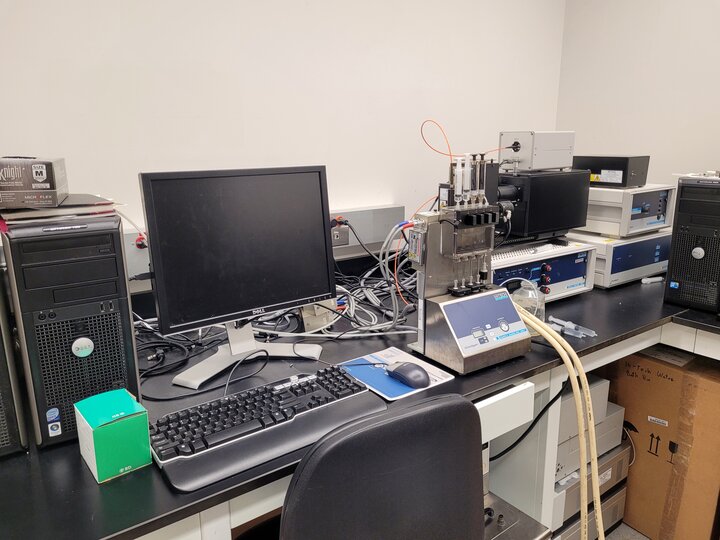
Isothermal calorimeter (ITC)
The Microcal VP-ITC is used for the study of macromolecule-ligand or macromolecule-macromolecule binding processes. The the cell compartment requires 1.42 mL of solution of one of the binding partners and 0.3 mL customizable syringe for the second binding partner. The minimal recommended macromolecule concentration is >10 uM, while the minimum binding partner solution concentration should be >120 uM, in order to achieve binding saturation.
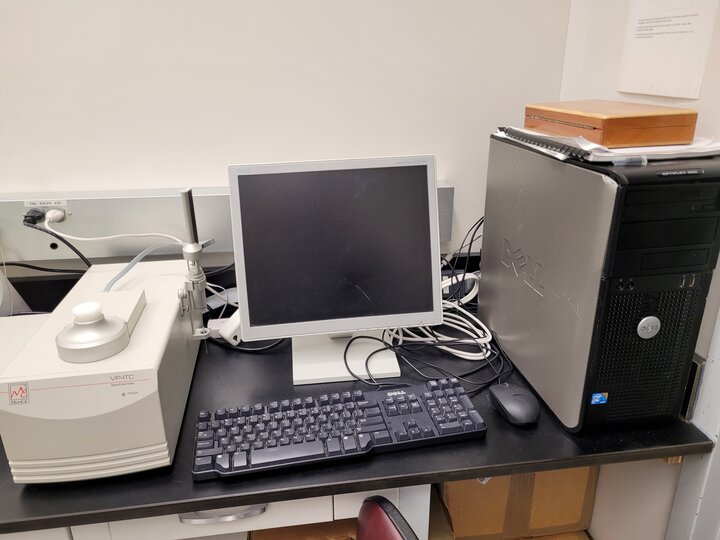
Differential Scanning Calorimeter (DSC)
The Microcal VP-DSC is employed for thermal denaturation studies, within the range from 10 to 130 oC), of biological molecules. The differential heat is calculated by comparing the two compartments, each with a volume of 0.7 mL. The recommended concentration of protein is typically below 1 mg/mL. The DSC can also be used for the differential stability studies of ligand binding.
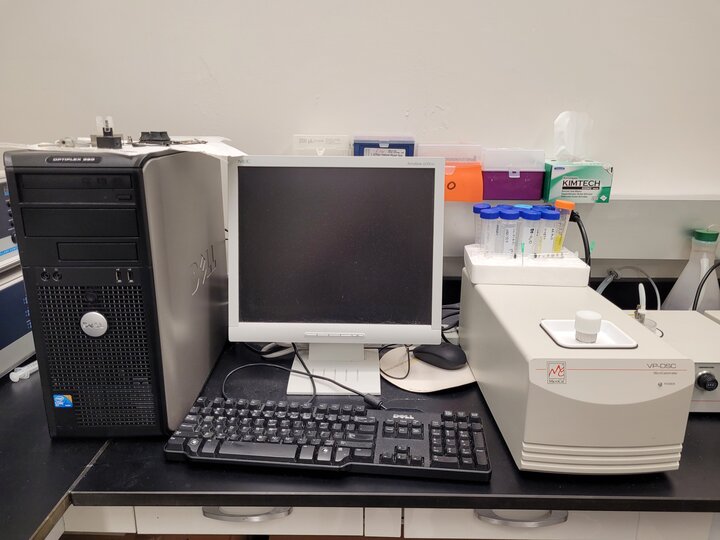
Circular dichroism (CD)
The Jasco J-815 instrument is equipped with the CD detector, fluorescence detector and fluorescence polarization (FP) accessories. It also has a stopped-flow accessory for the kinetic study of protein unfolding processes. The typical amount of protein sample required is 200 uL for the 1mm path rectangular cell and 1200 uL for the 0.1mm path cylindrical cell. The buffer required must be transparent into the far-UV (180-240 nm) region of the spectrum, in order to be able to record reliable spectra.
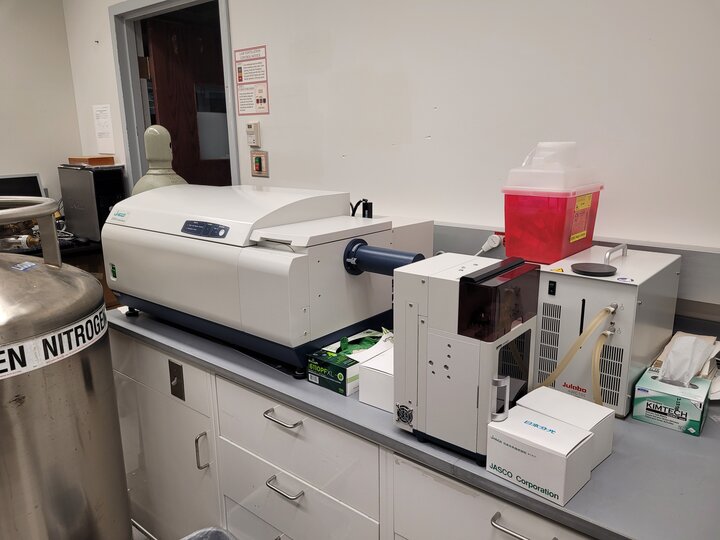
Cary Agilent Eclipse (Fluorescence)
The instrument can record excitation and emission spectra, fluorescence readings, phosphorescence spectra/readings. The instrument also has a polarization of fluorescence accessory (FP). The sample formats that are acceptable include micro, mini and standard size cuvets, multiple thermostated cuvet holder and 96-well plate accessory (FP measurements are not possible with the plate accessory).
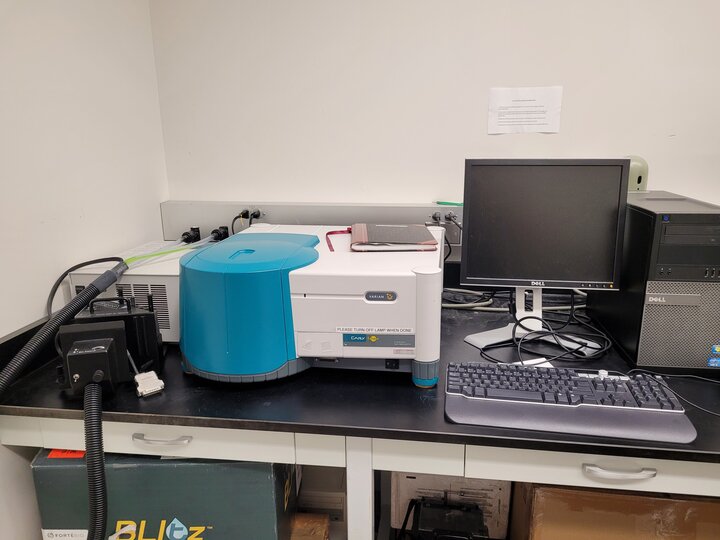
Sartorius Biolayer Interference (BLI)
This single channel instrument uses biosensors that can be provided by the users, containing a variety of immobilization modalities, such as streptavidin, anti-IgG subunits, His-Tag and thiol chemistries. The light interference of a few nanometers relies on the change in the mass of the immobilized molecule upon interaction with a macromolecule in solution. The volume of the binding position is just 4 uL, while for the wash position 250 uL is required.
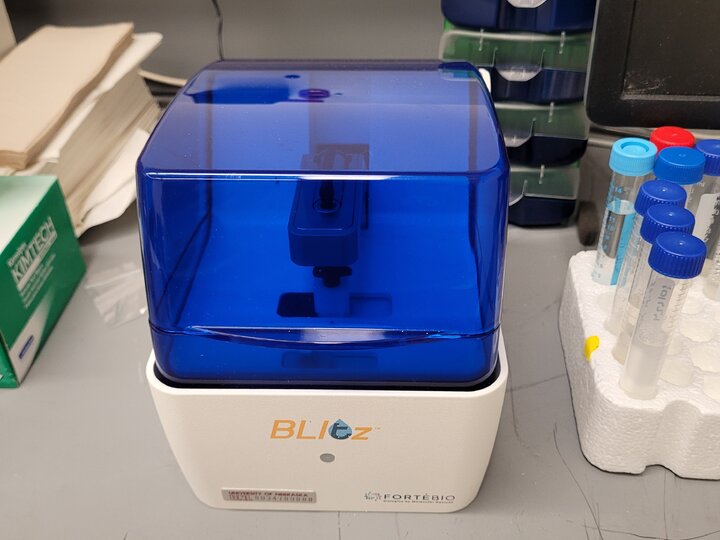
Recent Publications
Oseeyi I. Daudu, Kaylen R. Meeks, Lu Zhang, Javier Seravalli, John J. Tanner, and Donald F. Becke. ACS Omega, 2023. Jan 2023. doi.org/10.1021/acsomega.2c07788. Functional Impact of a Cancer-Related Variant in Human Δ1‑Pyrroline-5-Carboxylate Reductase-1.
Eva Nývltová, Jonathan V Dietz, Javier Seravalli, Oleh Khalimonchuk, Antoni Barrientos. Nat.Commun., 2022, Jun 24;13(1):3615. doi.org/10.1038/s41467-022-31413-1. Coordination of metal center biogenesis in human cytochrome c oxidase.
Sagar M. Patel, Javier Seravalli, Kyle M. Stiers, John J. Tanner, Donald F. Becker. Amino Acids, 2021 Dec; 53(12):1863-1874.doi.org/10.1007/s00726-021-03095-4. Kinetics of human pyrroline-5-carboxylate reductase in L-thioproline metabolism.
Yizi Mao, Javier Seravalli, Thomas G Smith, Martha Morton, John J. Tanner, Donald F. Becker.Biochemistry, 2021, 30;60(47):3610-3620. doi.org/10.1021/acs.biochem.1c00625. Evidence for Proline Catabolic Enzymes in the Metabolism of Thiazolidine Carboxylates.
Jonathan Herskovitz, Mahmudul Hasan, Jatin Machhi, Insiya Mukadam, Brendan M Ottemann, James R Hilaire, Christopher Woldstad, JoEllyn McMillan, Yutong Liu, Javier Seravalli, Anandakumar Sarella, Howard E. Gendelman, Bhavesh D. Kevadiya. Nanotheranostics. 2021 5(4):417-430. doi.org/10.7150/ntno.59568. eCollection 2021. Europium sulfide nanoprobes predict antiretroviral drug delivery into HIV-1 cell and tissue reservoirs.
Sagar M. Patel, Javier Seravalli, Xinwen Liang, John J. Tanner, Donald F Becker. Arch Biochem Biophys. 2021 30;703:108852. doi.org/10.1016/j.abb.2021.108852. Epub 2021 Mar 24. Disease variants of human Δ 1-pyrroline-5-carboxylate reductase 2 (PYCR2).
Lise Pingault, Nathan A Palmer, Kyle G Koch, Tiffany Heng-Moss, Jeffrey D Bradshaw, Javier Seravalli, Paul Twigg, Joe Louis, Gautam Sarath Int.J.Mol.Sci. 2020 21(21):7966. doi.org/10.3390/ijms21217966. Differential Defense Responses of Upland and Lowland Switchgrass Cultivars to a Cereal Aphid Pest.
Sagar M Patel, Thomas G Smith, Martha Morton, Kyle M Stiers, Javier Seravalli, Stephen J Mayclin, Thomas E Edwards, John J Tanner, Donald F Becker. Biochemistry 2020 Sep 15; 59 (36):3285-3289. . Cautionary Tale of Using Tris(alkyl) phosphine Reducing Agents with NAD +-Dependent Enzymes.
Kyle G Koch, Nathan A Palmer, Teresa Donze-Reiner, Erin D Scully, Javier Seravalli, Keenan Amundsen, Paul Twigg, Joe Louis, Jeffrey D Bradshaw, Tiffany Marie Heng-Moss, Gautam Sarath. Front.Plant.Sci. 2020, Jul 30;11:1145. doi.org/10.3389/fpls.2020.01145. Aphid-Responsive Defense Networks in Hybrid Switchgrass.
Bohan Zhang, Dmitriy I Podolskiy, Marco Mariotti, Javier Seravalli, Vadim N Gladyshev. Aging Cell 2020 May;19(5):e13119. doi.org/10.1111/acel.13119. Epub 2020 Apr 23. Systematic age-, organ-, and diet-associated ionome remodeling and the development of ionomic aging clocks.